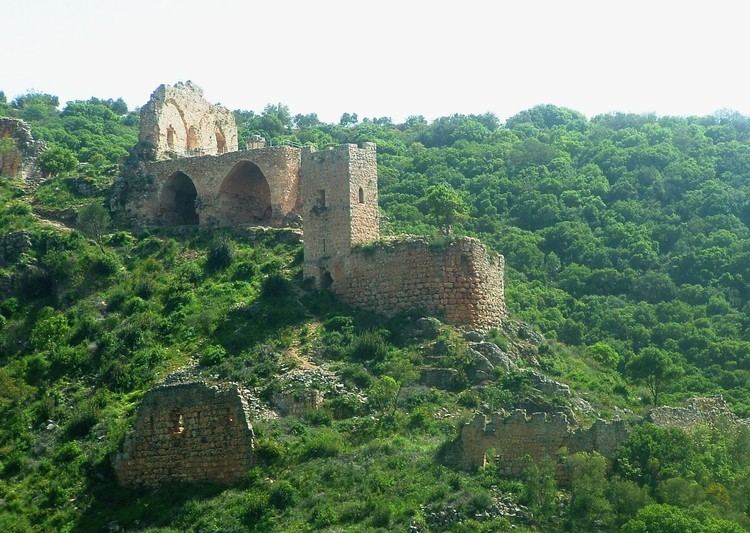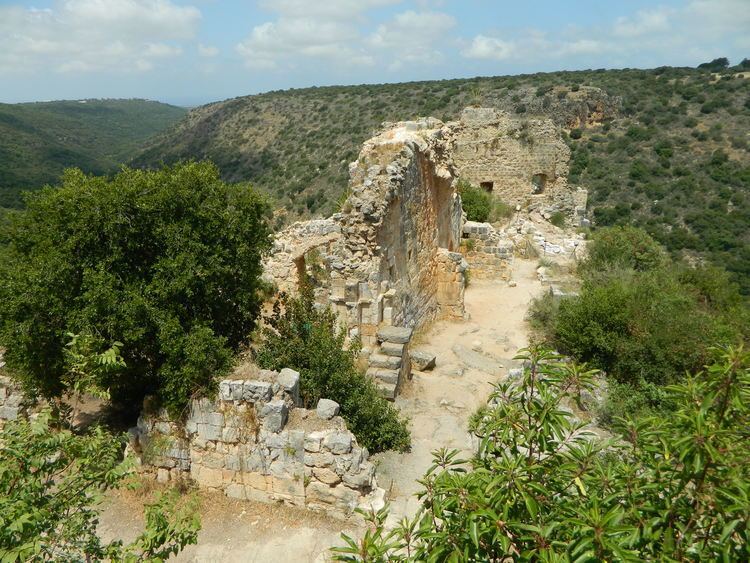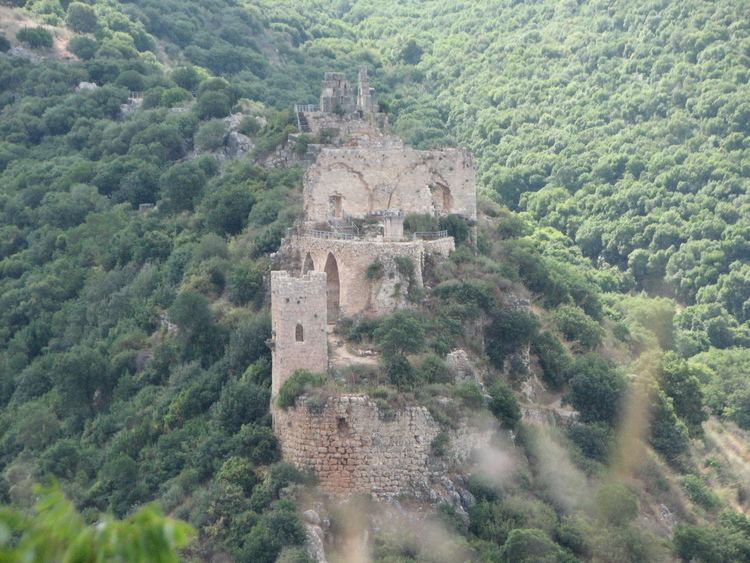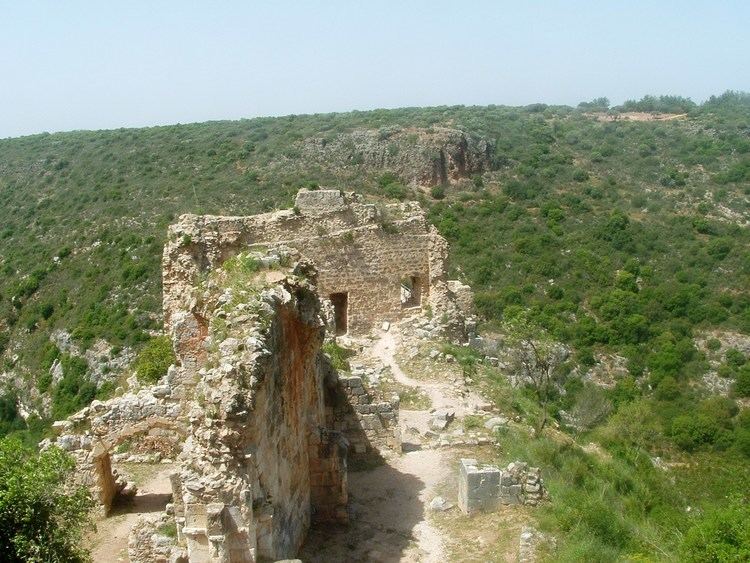Condition Ruins | Open tothe public Yes Built Mid-12th century | |
 | ||
In use Mid-12th century - 1271 Similar Nahal Sarach Reserve, Nahal Betzet, Nahal Ayun, Nachal Dišon, Bar'am Forest | ||
Montfort castle 2015
Montfort (Hebrew: מבצר מונפור, Mivtzar Monfor) is a ruined crusader castle in the Upper Galilee region in northern Israel, about 22 miles (35 km) northeast of the city of Haifa and 10 miles (16 km) south of the border with Lebanon.
Contents
- Montfort castle 2015
- Mtb dima dolgov nahal kziv montfort castle
- Etymology
- History
- Architecture
- Excavations
- References

The site is now a national park inside the Nahal Kziv nature reserve, and is an important tourist destination attracting many visitors from inside and outside Israel.

Mtb dima dolgov nahal kziv montfort castle
Etymology

The name of the fortress derives from the two French words mont (a mountain) and fort (strong), meaning the "strong mountain". It was built on land that the Teutonic Order purchased from the French De Milly family in the 1220s and is one of the finest examples of fortified building architecture in Outremer., the fortress was accordingly called Starkenberg, meaning the same phrase in German (stark meaning strong, and berg meaning mountain).
History

Montfort was the principal castle of the military Teutonic Order, which was founded in the late 12th century in the port city of Acre. The fortress is built on a narrow and steep cliff above the southern bank of Nahal Kziv in the Upper Galilee region, about 8 mi (13 km) northeast of the city of Nahariya. Unlike many other crusader fortresses in the Holy Land, this fortress was not originally built for military purposes, but was built to move some of the order's administration, such as the archives and treasury, from Acre to a more isolated location. The Teutonic Order had at the time come under pressure from the Templars and the Hospitallers in Acre, who had designs of taking it over.

Soon after the Crusaders conquered the Holy Land from the Muslims in 1099 during the First Crusade, European settlers (apart from the Crusaders themselves) began to populate the land. The noble French De Milly family received the estate and began to cultivate the land, turning it into a farming estate. In 1187 Muslims under the leadership of Saladin managed to defeat the Crusaders and take over Jerusalem following the Battle of Hattin. Along with Jerusalem, the property which was to be the Montfort castle became a Muslim possession as well. The Muslims, just like their Crusader predecessors, did not find the property particularly significant. The farmland lacked strategic importance because it was situated inland, above a stream channel, far away from any borders or main means of transportation.

Saladin's victory triggered the Third Crusade between 1189 and 1192. Led by King Richard I of England, the Third Crusade ended with a substantial Crusader victory. Nonetheless, the territories of the Kingdom of Jerusalem were much smaller in size than those from before Saladin's conquests. Most of the central Judea and Samaria mountains (including Jerusalem) remained under Muslim control, and the crusaders ruled mainly in the coastal plain and the Galilee. As the crusaders set their new capital in Acre, the significance of the Montfort estate increased, due to the proximity of the property to the new capital (8 mi). Although the De Milly family received the territory after its recapture during the Third Crusade, they sold it to the Teutonic Knights in 1220. The German knights began to renovate the buildings of the estate and, following internal conflicts between themselves and the Knights Templar and Knights Hospitaller, it was imperative for the Teutonic Knights to leave Acre for a separate headquarters, and the property (on which the Montfort was soon to be built) was a natural choice.
Following a formal request of assistance by Grand Master Hermann von Salza to Pope Gregory IX, the latter sent numerous fiscal contributions by many pilgrims and European citizens, to aid in the renovation of the new property. With the help of these contributions, the Teutonic Knights fortified the property and turned it into a magnificent fortress. The knights set their headquarters, archive, and treasury at the new property in 1229. By that time the property ceased being simply a farming estate and was considered a fortress with all its implications. The Teutonic Knights expanded the fortifications and built a keep in the center; the keep is now the main remnant of the ruined fortress.
The Mamluk leader Baibars besieged the fortress in 1266. However, the defenders of the fortress resisted and eventually compelled the Mamluk invaders to leave. Five years later, however, after most of the Crusader strongholds had fallen into Baibars' hands, the Mamluk leader returned to the fortress in 1271, and managed to topple the fortress' external southern wall using several military engineering battalions. This operation facilitated the Mamluks' stay in the area and after fifteen days of siege, the Teutonic Knights inside the fort surrendered. Due to prior negotiations between Baibars and the Crusaders, the latter were allowed to leave the fortress with all of their belongings and return to Acre. After the fall of that city in 1291, the Teutonic Knights made Venice their headquarters.
Architecture
Montfort is a spur castle on a narrow ridge projecting from a larger hill. The defences are concentrated at the most vulnerable eastern side where the spur joins the hill. On that side there are two ditches in front of a large D-shaped tower. The entrance to the castle is on the opposite side, with a smaller entrance tower guarding it. As the top of the spur is quite narrow, the main residential buildings are arranged in sequence between these two towers along the top of the ridge, with the vaulted hall being the most notable one. On the northern side, there are remnants of an outer defensive wall.
Excavations
The castle was surveyed in 1877 by Horatio H. Kitchener for the British Survey of Western Palestine.
Archaeological excavations at Montfort occurred in 1926 in an expedition organised by Bashford Dean, curator of the Arms and Armour Department of the Metropolitan Museum of Art in New York. William L. Calver was chosen by Dean to head the excavation.
A four-week season of excavations was conducted in the summer of 2011, organised by Professor Adrian Boas from the University of Haifa and supported by the Society for the Study of the Crusades and the Latin East. Excavations have continued every summer since then and most recently in summer 2016. In August 2015 and 2016 the excavations were aided by students from Royal Holloway, University of London.
